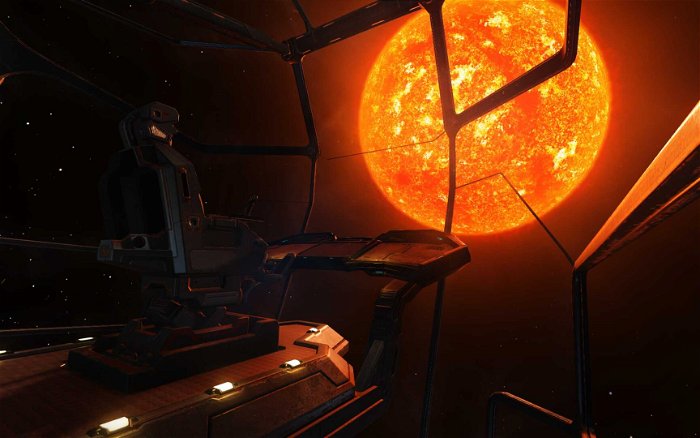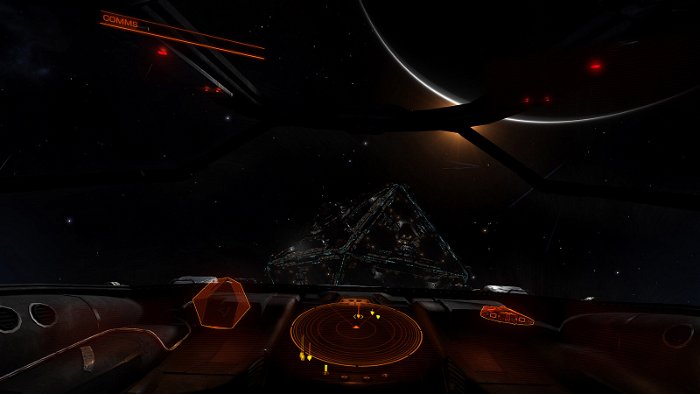Out of the short 200,000 years humans have existed, we’ve spent over 90% wandering without a home to tie us down. Perhaps in the future we will once again be nomadic? Elite: Dangerous is a game that goes some way towards capturing the adventurous nature of the wanderer. More often than not, you’ll see Elite described as a “space trading” game, an interstellar-truck simulator where you load your spaceship with strange futuristic goods – Aquaponic Systems and Bauxite minerals – and then ship these across the empty expanse in order to make a quick buck.
Whilst Elite can feature plenty of mundane back and forth couriering, there are other ways to play. One of the game’s greatest strengths is the spaceships themselves. Even the starter vessel, the “Sidewinder”, is sleek and nimble, with a beautifully rendered cockpit and enough flashing buttons and HUD elements to keep you infinitely distracted. After years of mindlessly controlling avatars with two legs and feet, the pure gadgetry and six degrees of freedom your ship offers is liberating. A joystick is the obvious way to fly, but a control pad works almost as well.

There’s plenty of adventure to be found in Elite from the get go. If shipping goods across the desolate void doesn’t sound like an appealing process, then the Sidewinder is equipped for you to go out and look for trouble. The best thing about the beginner ship is that it costs nothing to replace, which means you’re free to make mistakes/be blown to bits!
Adventure can come in a variety of forms. You can pick up pirate-hunting missions at one of the monolithic space stations, but I found it simpler to scour the interplanetary medium for “Unidentified Signal Sources”. Once you disengage your ship’s superluminal cruise mode at one of the Signal Sources, you’ll be in a pocket of space where a random event occurs. You might find stolen art floating amongst ship wreckage, or a wanted criminal that you can claim a bounty for. The Signal Sources are a great way for you to quickly find something interesting, and to make a decent profit whilst honing your pilot skills and making sure your laser-beams function. Unlike missions, the random Signal Sources are found all over the Milky Way, so you’ll never be tied down to one area.

Elite’s trade-based economy means there’s a fascinating network of interaction between couriers, pirates and bounty hunters. There’s enough players shipping valuable goods across space to make piracy appealing, and enough pirates to make hunting them profitable. This is good because it means you don’t have to be moving goods to get in on the action. Combat involves plenty of finesse, and it’s easy for a small ship like the Sidewinder to outmanoeuvre bigger vessels (particularly ships built for trade and couriering, if you want to go down the pirate route). For an extra challenge, you can switch off your ship’s “Flight Assist”. This means full Newtonian physics – if you fire your thrusters off, your ship will continue to move in that direction until you apply an equal counter-force. It’s tricky to get used to, but allows for some truly balletic manoeuvres. The combat is a complex dance full of kinetic energy, flashes of laser light, and backed up by outstanding audio feedback.
Once you’ve made a bit of money from your adventuring you can kit out you spaceship, or purchase a new one. The Viper is the best dog-fighter in the game – perfect for bounty hunting – and it won’t take you long to afford. Similarly, the Cobra Mk. III is an all-rounder great for piracy and exploration. Elite is a game where combat and adventure are easily accessible, but with a bit of investment, exploration can be one of the most rewarding experiences. With an upgraded faster-than-light “Frame Shift Drive” and a scoop that allows you to refuel at stars, you can escape the banality of space-capitalism for good and begin to explore the infinite.

Elite: Dangerous’ galaxy is as sublime as it is vast. An obsidian sphere eclipsing a distant red giant, binary stars of immense proportions, suns spitting out great flares of nuclear fire; these are just some of the images burnt into my memory. Only a fraction of the Milky Way’s 400 billion star systems have been explored, but already players have found countless black holes and Earth-like planets floating in the dark. Some have travelled as far as the centre of the galaxy to confront the supermassive Sagittarius A*, or journeyed into the midst of brightly lit nebulae and the “stellar nurseries” where stars form. Others simply wander deeper into the unknown. One thing is for sure, life in space doesn’t have to be all about credits.



